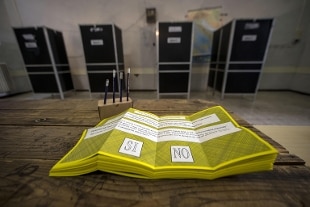- Reforms, collected signatures for the referendum
- Electoral law, from the Cassation go-ahead to the referendum
- Electoral law, the question of the League referendum
Share
10 January 2020 With the deposit of 71 signatures of senators, 7 more than what the Constitution requires, the constitutional referendum on the cutting of parliamentarians is approaching. The final word belongs to the Court of Cassation, which will have to verify the regularity of the signatures. If everything is regular, the popular consultation should take place in the spring, in a window that runs from late April to June.No quorum: the matter is governed by article 138 of the Constitution. The revision laws of the Charter and the other constitutional laws are adopted by each Chamber with two successive deliberations at intervals of not less than three months, and are approved by an absolute majority of the members of each Chamber in the second vote. The laws themselves are submitted to a popular referendum when, within three months of their publication, one fifth of the members of a House or five hundred thousand electors or five Regional Councils request them. The referendum law is not promulgated unless it is approved by the majority of valid votes. Therefore, for the validity of the constitutional referendum there is no minimum quorum of voters. It is sufficient that the consents exceed the unfavorable marks. If the result of the consultation is positive, the Head of State promulgates the law. Otherwise it is as if the law itself had never seen the light of day and the outcome of the consultation is published in the Official Journal.
When to vote: the popular consultation could take place between the end of April and June. From the day of filing the signatures to the Court of Cassation, the latter will express itself within 30 days, by order, on the legitimacy of the request. If the signatures are regular, the Cassation communicates the admission of the referendum to the President of the Republic, the Presidents of the Chambers, the President of the Council of Ministers and the President of the Constitutional Court. Within the following 60 days, the law provides, the referendum must be called by decree of the President of the Republic, upon resolution of the Council of Ministers. The date must be fixed on a Sunday between the 50th and 70th day following the issue of the decree of call.
The precedents: if it takes place, the referendum on the parliamentarians' cut will be the fourth constitutional referendum confirming the history of the Republic. The first was that of 7 October 2001, when the referendum took place to confirm or not the reform of Title V of the Charter. the reform was confirmed with 64.2% in favor, although the turnout was very low, around 34%. The second confirmatory constitutional referendum took place in June 2006 and concerned the constitutional reform launched by the Berlusconi government and renamed Devolution. The Italians rejected the reform with 61% of the no, while the turnout was 52%. Finally, the third constitutional confirmatory referendum took place on December 4, 2016, and the rejection of the reform that eliminated perfect bicameralism decreed the end of the Renzi government, with the resignation of the Prime Minister. To say no it was 59.11%, against 40.89% yes. The turnout was record, almost 69%.

